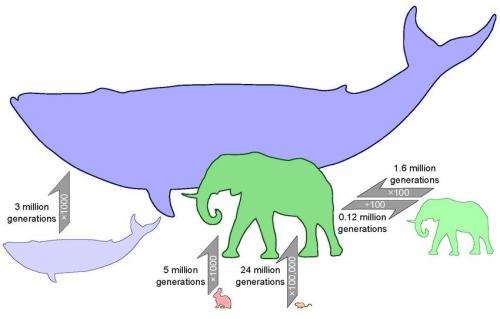Mouse to elephant? Just wait 24 million generations

Scientists have for the first time measured how fast large-scale evolution can occur in mammals, showing it takes 24 million generations for a mouse-sized animal to evolve to the size of an elephant.
Research published today in the Proceedings of the National Academy of Sciences (PNAS) describes increases and decreases in mammal size following the extinction of the dinosaurs 65 million years ago.
The research also shows it took about 10 million generations for a cat-sized terrestrial mammals to evolve into the size of an elephant. Sea mammals, such as whales took about half the number of generations to hit their maximum.
Led by Dr Alistair Evans of Monash University's School of Biological Sciences a team of 20 biologists and palaeontologists discovered that rates of size decrease are much faster than growth rates. It takes only 100,000 generations for very large decreases, leading to dwarfism, to occur.
Dr Evans, an evolutionary biologist and Australian Research Fellow, said the study was unique because most previous work had focused on microevolution, the small changes that occur within a species.
"Instead we concentrated on large-scale changes in body size. We can now show that it took at least 24 million generations to make the proverbial mouse-to-elephant size change – a massive change, but also a very long time," Dr Evans said.
"A less dramatic change, such as rabbit-sized to elephant-sized, takes 10 million generations."
The paper looked at 28 different groups of mammals, including elephants, primates and whales, from various continents and ocean basins over the past 70 million years. Size change was tracked in generations rather than years to allow meaningful comparison between species with differing life spans.

Dr Erich Fitzgerald, Senior Curator of Vertebrate Palaeontology at Museum Victoria and a co-author, said changes in whale size occurred at twice the rate of land mammals.
"This is probably because it's easier to be big in the water – it helps support your weight," Dr Fitzgerald said.
Dr Evans said he was surprised to find that decreases in body size occurred more than ten times faster than the increases.
"The huge difference in rates for getting smaller and getting bigger is really astounding – we certainly never expected it could happen so fast!" Dr Evans said.
Many miniature animals, such as the pygmy mammoth, dwarf hippo and 'hobbit' hominids lived on islands, helping to explain the size reduction.
"When you do get smaller, you need less food and can reproduce faster, which are real advantages on small islands," Dr Evans said.
The research furthers understanding of conditions that allow certain mammals to thrive and grow bigger and circumstances that slow the pace of increase and potentially contribute to extinction.
Provided by Monash University




















